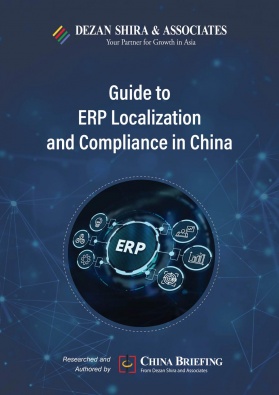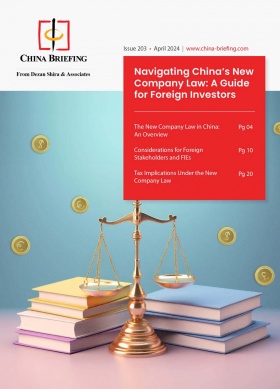Understanding the Relaunched China Certified Emission Reduction (CCER) Program: Potential Opportunities for Foreign Companies
The China Certified Emission Reduction (CCER) program has emerged as a pivotal component of China’s broader strategy to combat climate change and transition towards a greener economy. By incentivizing companies to voluntarily engage in emission reduction activities and facilitating the trading of carbon credits, CCER presents significant opportunities and challenges for businesses operating within China.
As companies navigate the complexities of compliance, trading, and reporting within the CCER framework, they must also contend with the broader implications for their operations, finances, and strategic objectives.
This article explores the multifaceted impact of the CCER program on companies operating in China, examining both the opportunities for innovation and growth, as well as the potential risks and compliance considerations.
What is China Certified Emission Reduction (CCER) program?
On January 22, 2024, China initiated the China Certified Emission Reduction (CCER) program, enabling companies within specific sectors to trade their carbon reduction credits following their voluntary engagement in emission-reduction initiatives. This program supplements the country’s existing Emissions Trading System (ETS), which has been operational since July 2021 and is limited to enterprises with designated emission quotas. The CCER aims to incentivize the growth of certain industries, particularly those in clean energy, to accelerate the nation’s transition towards environmental sustainability and support its carbon-neutral objectives.
Initially, the CCER will focus on four sectors: afforestation, solar thermal power, offshore wind power, and mangrove vegetation creation. Companies operating within these sectors can register their accredited carbon reduction credits in the CCER system for trading purposes. These sectors were chosen due to their reliance on carbon credit sales for profitability. For instance, offshore wind power generation, as more costly than onshore alternatives, stands to benefit from additional revenue streams facilitated by CCER transactions.
Currently, primary buyers are expected to be high-emission enterprises seeking to offset their excess emissions and companies aiming to demonstrate corporate social responsibility by contributing to environmental conservation. Eventually, the program aims to allow individuals to purchase credits to offset their carbon footprints. Unlike the mandatory national ETS, the revamped CCER scheme permits any enterprise to buy carbon credits, thereby expanding the market scope.
The Ministry of Ecology and Environment (MEE) oversees the CCER program, having assumed responsibility for climate change initiatives from the National Development and Reform Commission (NDRC) in 2018. Verification agencies and project operators are mandated to ensure transparency and accuracy in disclosing project details and carbon reduction practices.
On the second day after the launch on January 23, the first transaction in China’s voluntary carbon market saw the China National Offshore Oil Corporation (CNOOC), the country’s largest offshore oil and gas producer, purchase 250,000 tons of carbon credits to offset its emissions.
China’s carbon trading system
China’s carbon trading landscape consists of two primary components: the China Certified Emission Reduction (CCER) scheme and the Emissions Trading Scheme (ETS). The CCER scheme, first launched in 2012, initially permitted companies to offset a portion of their emissions—up to 5 percent—by procuring credits from specific emission reduction projects like afforestation and renewable energy generation. However, the CCER program halted in 2017 due to low trading activity and inadequate standardization in carbon auditing, while credits generated between 2012 and 2017 remained tradable.
The ETS, launched in 2021, mandates certain companies to monitor and account for their carbon dioxide (CO2) emissions, also allowing them to offset a portion—also up to 5 percent—of their annual emissions using carbon credits. Initially, the ETS exclusively targeted the power sector, but there have been plans to expand its coverage to include other high-emission industries, as per expert projections. Remarkably, the ETS stands as the world’s largest carbon trading market by greenhouse gas emission volume, covering 2,532 major emitters from China’s power generation sector alone. This sector contributed approximately 4.7 billion tons of carbon emissions in 2022, constituting roughly 40 percent of the nation’s annual emissions. Entities exceeding their assigned emission caps are obligated to purchase equivalent carbon allowances to offset their surplus emissions.
Forecasts from the China Beijing Green Exchange (CBGEX) anticipate significant growth in China’s carbon market following its future financialization. With an estimated quota of 7 to 8 billion tons, annual trading volumes are projected to surpass 10 billion tons, translating to a transaction value exceeding RMB 1 trillion (US$140 billion).
The latest, “enhanced” CCER scheme is poised to complement the ETS by introducing a broader array of carbon financial instruments and trading products, aiming to expedite China’s journey toward carbon neutrality by 2060. In addition to CO2, the CCER encompasses five other greenhouse gases, including methane, nitrous oxide, and hydrofluorocarbons, underscoring its comprehensive approach to emissions mitigation.
Carbon Market Development in China
Carbon asset custody includes the management and trading of carbon assets. Custodian institutions oversee these assets, facilitating collective management and trading. While initially focused on emission quotas, custodian services have broadened to include carbon trading execution and low-carbon project financing. In recent years, carbon markets have emerged across various pilot regions in China, each fostering its own set of practices and initiatives. For example, at the very beginning, areas like Tianjin and Chongqing concentrated primarily on financing carbon emission quota pledges, while other cities, such as Beijing, Shanghai, Shenzhen, Guangzhou, focus on developing carbon financial instruments.
Alongside the establishment of regional carbon markets, there has been a notable rise in participation from financial entities and market players in carbon trading, low-carbon investments, and green financing. This includes banks, brokers, trust companies, fund managers, and other intermediaries, as well as investors. Notably, carbon financing instruments, such as carbon asset pledges, transfers, and guarantees, have gained traction due to their straightforward transactional nature. For instance, in 2021, the Hubei branch of the Agricultural Bank of China issued a groundbreaking pledge loan of RMB 10 million (US$1.4 million) for carbon emission rights to the Hubei Sanning Chemical Industry, marking a significant milestone in the national carbon trading market. Additionally, entities have introduced carbon bonds to fund emission reduction projects, with a focus on carbon-neutral green bonds and asset-backed securities supporting carbon-neutral initiatives.
In terms of financial products, carbon trading instruments like options, forwards, futures, and swaps are primarily practiced in pilot regional markets. Moreover, carbon supporting instruments, such as carbon indices, insurance, and funds, have emerged to enhance market stability and facilitate investment in carbon-related ventures. Carbon indices, like those from the Beijing Green Exchange and Fudan University, offer insights into market trends and price changes. Carbon insurance products aim to mitigate default risks in various carbon-related activities, including trading and asset financing. Additionally, carbon funds serve as investment vehicles for supporting green and low-carbon initiatives, providing investors with opportunities to contribute to carbon reduction efforts while yielding returns.
Carbon market compliance and financialization
Financialization within the carbon market is drawing significant attention, particularly as regulatory frameworks become more comprehensive and market liquidity continues to strengthen. In 2023, the Shanghai Environment and Energy Exchange (SEEE), home to the China Emission Allowances (CEA) trading platform, began to differentiate CEA products based on vintages. The China Securities Regulatory Commission has granted approval to several securities companies for CEA trading, pending further approval from the Ministry of Ecology and Environment (MEE). However, the introduction of financial derivatives and market makers is anticipated to potentially amplify supply and demand fluctuations, leading to increased price volatility.
Given that China’s compliance market is still in its infancy, many participants anticipate a gradual start to its financialization while uncertainty also exists, especially regarding the extent of progress that will be achieved in 2024.
Carbon markets and initiatives worldwide
Emission reduction initiatives similar to the CCER are being implemented worldwide. The European Union (EU) stands out as a pioneer in this area with the launch of its Carbon Border Adjustment Mechanism (CBAM) in 2023. CBAM imposes a carbon tax on emission-intensive commodities imported into the EU, and at this time, covers specific sectors such as cement, iron and steel, aluminum, fertilizer, electricity, and hydrogen. The tax is designed to bridge the gap between carbon costs in the EU and exporting countries, ensuring fair competition and preventing the relocation of EU producers to regions with less stringent environmental regulations.
According to forecasts from S&P Global Commodity Insights, between 2026 and 2040, China is projected to export approximately 868.94 million metric tons of CBAM-liable commodities. Iron and steel account for 42 percent of these exports, followed by cement at 8 percent, and aluminum at 6 percent.
In 2023, factories emitting over 26,000 tons of carbon dioxide annually across seven pivotal industries were mandated to verify their emissions data for the year 2022. This directive, as outlined in a document published on the ministry’s website, applied to various sectors, including iron and steel, non-ferrous metals, building materials, refining and petrochemicals, chemicals, papermaking, and civil aviation. This verification process marks a significant step toward expanding the compliance market, ensuring rigorous oversight and accountability within key sectors contributing to carbon emissions.
Factories in China must verify their emissions data annually in a centralized reporting process for exporters to meet CBAM standards. Efforts to establish a robust reporting system are aimed at helping China address challenges posed by CBAM and better prepare enterprises for EU tariffs. Standardizing emission measurement and reporting practices across regions is crucial not only for combating global warming but also for facilitating international trade.
However, CBAM has faced criticism for potentially erecting trade and technological barriers under the guise of climate change mitigation. Some argue that CBAM could hinder the development prospects of developing countries and undermine the goals of the Paris Agreement. At the 28th session of the Conference of the Parties to the UN Framework Convention on Climate Change (COP28) in Dubai in December 2023, countries like Brazil, China, India, and South Africa expressed concerns. China has also proposed further discussions on CBAM at the World Trade Organization (WTO) in September 2023, emphasizing the integration of environmental policy tools with trade policies and addressing key topics, such as carbon emission default values, trade impacts, and data protection.
In addition to CBAM, discussions are underway regarding potential joint EU-U.S. actions to address excess steel production and reduce carbon emissions. Chinese companies are particularly wary of the prospect of a carbon border tax in the US, which they anticipate could be less aligned with WTO principles and potentially more hostile.
Impact on foreign companies in China
Foreign companies stand to capitalize on several opportunities within the CCER program, leveraging their expertise and experience in carbon trading, reporting, and financing tools. One significant avenue lies in technology transfer and collaboration, where foreign firms can share their advanced knowledge in low-carbon practices with Chinese partners.
Moreover, foreign companies bring valuable expertise in carbon reporting and compliance frameworks. By leveraging their experience, they can assist Chinese entities in accurately measuring, reporting, and verifying their emissions reductions. This collaboration not only strengthens the integrity of CCER credits but also fosters trust and confidence in China’s carbon market among international stakeholders.
Further, foreign companies can actively invest in emission reduction projects across China. These projects may include the development of renewable energy installations, afforestation initiatives, or energy efficiency upgrades. By financing these projects, foreign investors not only contribute to China’s transition to a low-carbon economy but also earn CCER credits based on the emissions reductions achieved.
About Us
China Briefing is one of five regional Asia Briefing publications, supported by Dezan Shira & Associates. For a complimentary subscription to China Briefing’s content products, please click here.
Dezan Shira & Associates assists foreign investors into China and has done so since 1992 through offices in Beijing, Tianjin, Dalian, Qingdao, Shanghai, Hangzhou, Ningbo, Suzhou, Guangzhou, Haikou, Zhongshan, Shenzhen, and Hong Kong. We also have offices in Vietnam, Indonesia, Singapore, United States, Germany, Italy, India, and Dubai (UAE) and partner firms assisting foreign investors in The Philippines, Malaysia, Thailand, Bangladesh, and Australia. For assistance in China, please contact the firm at china@dezshira.com or visit our website at www.dezshira.com.
- Previous Article New Business Prospects in China’s Waste Recycling Market
- Next Article China Takes Top Spot on Emerging Asia Manufacturing Index 2024



























